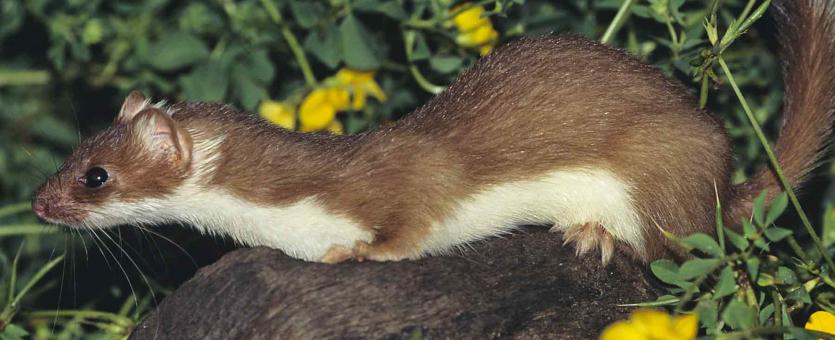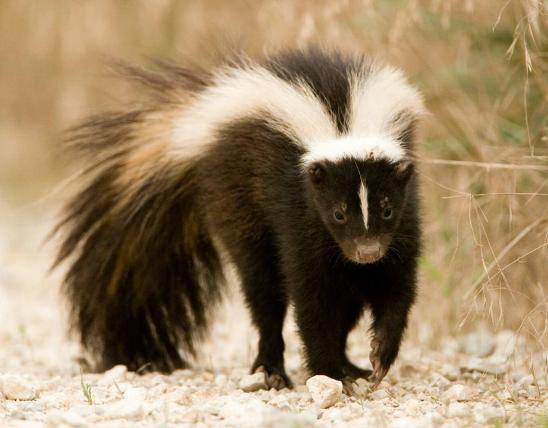
The long-tailed weasel is a slender, long-bodied mammal with short legs and well-furred tail about half the length of the head and body. The head is small, flattened, and only slightly larger in diameter than the long neck. The ears are short and rounded, the whiskers prominent, and the small eyes beady. In summer, adults are usually dark brown above and yellowish white below with a white chin and black tail tip. In winter, the coat is paler, but sometimes in northern Missouri they have an all-white coat except for the black tail tip.
Similar species:
- The American mink is larger (total length to 20–27 inches), all brown with a white chin and with white spots occurring irregularly on the throat, chest, and belly (not brown above and whitish below).
- The North American river otter is much larger (total length 35½ to 53 inches) and has fully webbed feet and a long, tapered tail that is thick at the base and flat on the bottom.
- The least weasel is a mouse-sized animal whose total length is only 5¾–9¾ inches and weight is just 1¼–2 ounces. The tail is very short, only ¾–1½ inches long, and less than 1/5 as long as the head and body. The tail lacks the prominent black tip of the long-tailed weasel. The least weasel occurs in Missouri's northern counties and is not expected to be found in the southern half of the state. Missouri is at the southern extent of its large North American range.
Males: total length: 13½–17½ inches; tail length: 4½–6¼ inches; weight: 6–9½ ounces. Females: total length: 11½–15½ inches; tail length: 3–5 inches; weight: 2½–4½ ounces.

Statewide. Most common in the south-central and southwestern portions.
Habitat and Conservation
Weasels live in a variety of habitats but prefer woodlands, brushy fencerows, and thickets along watercourses. Their home is a shallow burrow that was usually the former abode of a mole, ground squirrel, or mouse. They also live in rock piles, under tree roots, and in dense brushy vegetation.
While not abundant in our state, weasels should be encouraged and appreciated. Regulation of harvest is essential, as this species is state-ranked as vulnerable and is a species of conservation concern.
Food
Long-tailed weasels eat animal food entirely, preferring their prey alive and quivering. The only carrion consumed consists of prey they have stored in their burrows. As long as rodents are available, they are eaten almost exclusively. Major food items are mice, rats, squirrels, chipmunks, shrews, moles, and rabbits, and occasionally small birds, bird eggs, reptiles, amphibians, earthworms, and some insects. Despite their size, weasels are voracious predators.
Status
A species of conservation concern in Missouri. Rare in Missouri but most common in the south-central and southwestern portions. Population densities generally correspond to the abundance of mice, their major food source.
Life Cycle
Mating is usually in July or August, but the young are not born until the following April or May. The total gestation period averages 279 days, but the embryos undergo a long dormant period before implantation and further development. The single annual litter usually has 4–8 young. Weaning begins at about 5 weeks of age. Young males don’t mate their first summer, although females become sexually mature when 3–4 months old.
Human Connections
Fur was harvested in the past, but weasels no longer may be trapped in Missouri. Many weasels are destroyed by farmers who report them killing poultry. Certain individuals sometimes kill poultry, but the species as a whole causes little economic loss. Weasels eat large numbers of mice and rats.
Ecosystem Connections
Weasels are aggressive and ferocious predators that eat mice, rats, shrews, and even cottontail rabbits. They are also fed upon by other predators such as great horned owls, hawks, foxes, and bobcats.
Signs and Tracks

Front track:
- ¼–¾ inch long
- 4 (or 5) toes.
Hind track:
- ½–1 inch long
- 4 (or 5) toes.
Other notes:
- About one-half the size of mink tracks.
- Toe prints are often indistinct.
- Bounding, the tracks appear in squared clusters, the hind feet in front of fore feet.
- Distance between track clusters is 12–18 inches (bounding).
- Width of pattern (stride) is about 3 inches.
- Scats are long, dark, and slender, often deposited in prominent places such as on rocks or in trails.




























